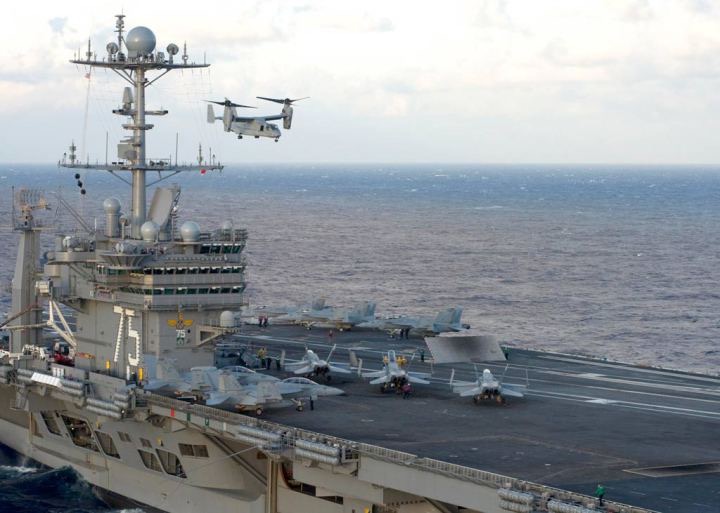The Navy will buy V-22 Osprey tiltrotors to replace its aging C-2A Greyhound turboprop aircraft in flying carrier on board delivery (COD) missions. The US Navy will buy four V-22s each year from fiscal 2018 to 2020.
The Marine Corps and other Osprey advocates, have argued for years that the Navy should replace its aging conventional take off C-2As with vertical take off and landing V-22s.
The C-2As carry cargo, mail and passengers between aircraft carriers and shore. The first Greyhound prototypes flew in 1964. The Osprey is in service with the Marine Corps since 2007 and the Air Force since 2009, tilts two large wingtip rotors up to take off and land vertically and forward to fly like a turboprop airplane, giving it far greater speed and range than conventional helicopters.
Until the past couple of years, Navy leaders had shown little interest in actually buying their planned 48 Ospreys. But in 2011, the Marine Corps began qualifying its MV-22s for carrier landings, and a six-day “military utility assessment” conducted last summer off the coast of Florida, in which V-22s carried passengers and cargo to and from the USS Harry S Truman (CVN 75), found that: “The V-22 demonstrated an effective, flexible, and safe capability to conduct the COD mission with no modifications and no adverse impact to cyclic flight operations.”
The first dozen HV-22s would be taken from what would have been the Marine Corps share of V-22s built in fiscal 2018-20 under the prospective third multiyear contract. Those first Navy V-22s will be replaced in the Marine Corps inventory in fiscal years 2021, 2022, and 2023 with a dozen Ospreys “that would have been allocated to the Navy,” the memo provides.
breakingdefense

The fleet of the future will require reliability, versatility, flexibility, and capability in order to stay out in front of the threat. When we place this prospect within the Pacific Basin we add a whole new dimension to the equation, and divert fields may be far away. Other “Flies in the ointment” are specific and unique logistics requirements for things like outsized cargoes of the future. The F-35’s F135 engine in its shipping container for example. Then let’s add different operating environments that must be supported like an underway Carrier Strike Group (CSG) and an Expeditionary Strike Group (ESG) that may, or may not be in the immediate vicinity of each other, or the beach, and that also needs some of that unique logistics support in the form of a peculiar outsized cargo because they fly a similar aircraft with the same engine.
ReplyDeleteThe Pacific Basin requires flexibility of logistics support, within the context of underway units across a disparate group of aviation capable platforms. The KV-22 can carry an underslung F135 engine capsule as well. (e.g., V-22 COD).
The F-35 is the name of the game for the future in the Marine Corps earlier (2015), and the US Navy later. The F135 engine cannot be placed in either a 260kt cruise speed C-2 Greyhound, or 280kt cruise speed V-22 Osprey intact. However, the 350kt cruise speed S-3 Viking rebuild with a larger fuselage can provide the required support . . . and much more. Development and construction of a new and modern S-3 Viking capable of carrying the encapsulated F135 engine is very possible. Lockheed has already spent some time on this, and dropping the flag on this rapid prototype project would come on more quickly than a whole new airframe. Flexibility of fleet logistics support, and the KV-22 can carry an underslung F135 engine capsule as well.
Then finally the unforgiving Pacific Basin. Fuel is the key to success if you wish to have the largest probability of survival. The United States Navy has been without a robust and capable tanker aircraft since the retirement of the KA-6D and the S-3Bs. Time to build a mini KC-46A (multi-function tanker) for the Navy.
The new KC-3A will be a tanker and a COD. The VRC Squadrons will become composite squadrons operating KC-3A and KV-22 aircraft. The roll-on/roll-off equipment will be interchangeable except for the strap down fuel tanks themselves. This solution provides flexibility and capability to every CSG. A COMBI KC-3A could escort a jet back to the beach (or escort a flock of birds) and take cargo in half the cargo space on a single longitudinally loaded 463L pallet at the same time.
Results will be greater flexibility by the VRCs to be able to get the cargo to wherever it needs to go. The CSGs and ARGs will not have to rely on the ‘Hub and Spoke’ supply chain saving time and fuel (less cost with greater flexibility). The flexibility to resupply all forces anywhere will be added to the VRC tool kit and they will send a COD/Tanker DET to the underway platforms, thus expanding the Battle Force Commanders ability to accomplish his mission effectively and efficiently. Many future logistics problems will have a ready solution where in the past the enemy could count on our logistical train to act in a certain way due to equipment capabilities and limitations.
Development of a pressurized version of the KV-22 will extend its legs and facilitate the development of and introduction of the EV-22 for the MAGTF in support of ESG Operations in the future.